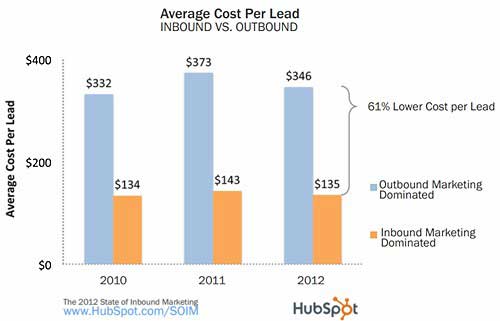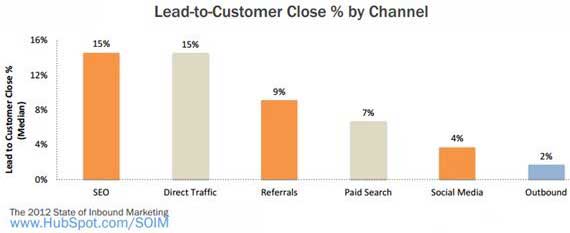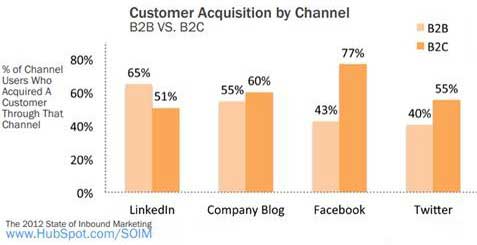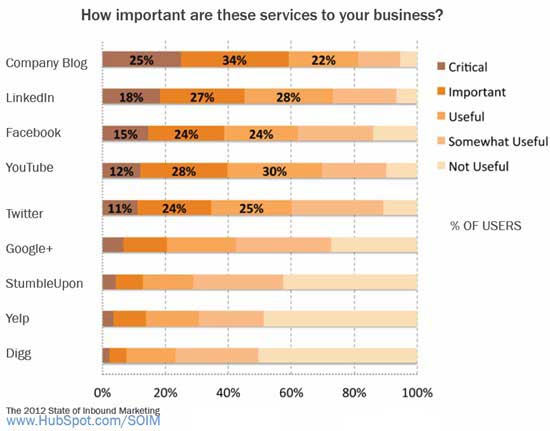Businesses that use primarily inbound marketing strategies for lead acquisition consistently report lower cost-per-lead (CPL) rates than those using outbound-centric strategies, according to the 2012 State of Inbound Marketing report by HubSpot.
Among companies with outbound marketing-dominated strategies—those that spend more than 50% of their lead-generation budgets on outbound marketing channels—the average CPL was $346 as of January 2012. By contrast, among inbound-centric companies (those spending over 50% of their lead-generation budget on inbound marketing) the average CPL was $135—61% less than the CPL of outbound-dominated businesses.

Moreover, the findings are remarkably consistent with previous years: In studies conducted by HubSpot in 2010 and 2011, inbound marketing-centric organizations registered 60% and 62% lower CPL, respectively.
"Inbound marketing" is defined by HubSpot as a set of marketing strategies and tactics focused on pulling the right prospects and customers towards a business and its offerings (i.e., programs that allow customers to find the business and offerings).
Common inbound marketing programs include organic search, various forms of social media, and blogging. Traditional outbound marketing techniques include direct mail, print advertising, and telemarketing.
Below, additional findings from HubSpot's fourth annual 2012 State of Inbound Marketing report, based on a survey of 972 business professionals who are familiar with their company's marketing strategy. Some 72% of respondents are from B2B organizations.
Low-Cost Marketing Channels
Blogging, social media, and SEO (organic search) are most likely to be reported as low-cost marketing channels:
- 52% of companies that publish a blog report leads from that channel are "below average cost."
- 45% of companies that use social media report leads from those channels are "below average cost."
- 38% of companies using SEO report leads from that channel are "below average cost."
By contrast, trade shows (19%), telemarketing (33%), and direct mail (34%) are less likely to be ranked as "below average cost." .
Inbound Channels Produce Higher Quality Leads
In addition to having a lower average CPL, inbound leads appear more likely to become customers.
Among a sample of 150 businesses using closed-loop marketing analytics, HubSpot analyzed the median lead-to-close rate of each business by lead source. Among those lead sources:
- Leads via SEO were more than seven times more likely to close than outbound-sourced leads (15% vs. 2%).
- Leads via inbound links (or referrals) were nearly five times more likely to become customers than outbound leads (9% vs. 2%).

Social Media, Blogs Generate Real Customers
Social media and company blogs appear to be helping companies generate leads that result in customers:
- 62% have acquired a customer via LinkedIn, up from 57% one year earlier.
- 57% have acquired a customer from their blog, the same proportion reported in last year's study.
- 52% have acquired a customer leads via Facebook, up from 48% a year earlier.
- 44% have acquired a customer via Twitter, up from 42%.
Interestingly, the frequency of blog posts appears to correlate positively with new customers acquired:
- 92% of companies that publish a blog multiple times per day have acquired a customer from their blog.
- 66% of companies that publish a blog weekly have acquired a customer from their blog.
- 43% of companies that publish a blog less than monthly have acquired a customer via blog.
LinkedIn More Effective for B2B; Facebook for B2C
Though B2C and B2B companies alike acquire customers via various social media channels, there is some disparity in the effectiveness of those channels, depending on business type:
- Among B2B companies, LinkedIn is the top channel: 65% report acquiring a customer via that channel.
- Among B2C companies, Facebook is the top channel: 77% report acquiring a customer via the social networking site.

Some 40% of B2B companies report having acquired a customer via Twitter, compared with 55% of B2C companies.
However, blogging appears more effective for B2B companies: 60% report acquiring a customer via their blog, compared with 55% of B2B companies.
What's Important to Marketers Now?
Asked to rate which channels have become more important to them over the past six months, marketing professionals cited the following:
- Social media: 62%
- SEO (organic search): 52%
- Blogs: 36%
- PPC (paid search): 20%
- Trade shows: 14%
- Direct mail: 10%
- Telemarketing: 9%
Blogs Still Most Important Media Channel
Similarly, asked to rate the services they use as "critical," "important," or "useful," 25% of marketing professionals rated their company blog as "critical" to their business; another 34% rated their blog as "important." Overall, 81% of marketing professionals rated company blogs as "useful" or better.

LinkedIn, YouTube, Facebook, and Twitter were considered "useful" or better by more than 60% of companies. By contrast, most users of StumbleUpon, Yelp, and Digg rated those channels "somewhat useful" or "not useful.''
Budgets
Inbound marketing budgets are up slightly: The average proportion of budget dedicated to inbound marketing rose from 32% in 2011, to 35% in 2012, whereas the percentage dedicated to outbound budgets fell slightly, from 24% in 2011, to 23% in 2012.
About the data: Findings from the 2012 State of Inbound Marketing report are based on a January 2012 survey of 972 professionals who were familiar with their company's marketing strategy. Respondents comprised marketers, business owners, entrepreneurs, and executives at companies of various sizes and industries. Some 72% of these professionals worked in B2B companies and the range of industries varied greatly.



